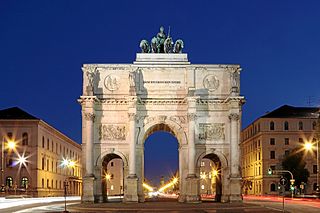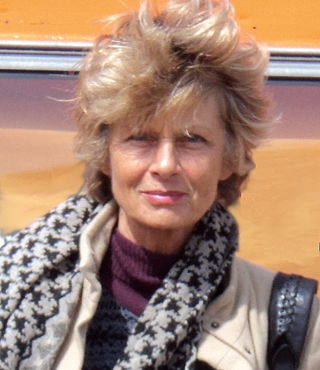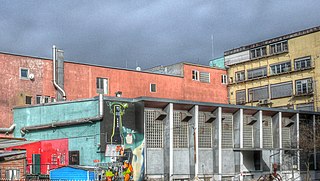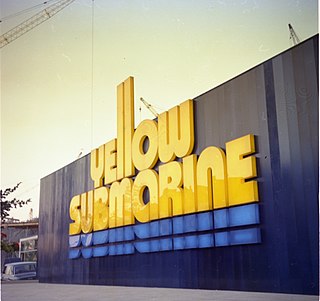
James Marshall "Jimi" Hendrix was an American guitarist, songwriter and singer. Although his mainstream career spanned only four years, he is widely regarded as the greatest and one of the most influential electric guitarists in the history of popular music, and one of the most celebrated musicians of the 20th century. The Rock and Roll Hall of Fame describes him as "arguably the greatest instrumentalist in the history of rock music."

Munich is the capital and most populous city of the Free State of Bavaria. With a population of 1,578,132 inhabitants as of 31 May 2022, it is the third-largest city in Germany, after Berlin and Hamburg, and thus the largest which does not constitute its own state, as well as the 11th-largest city in the European Union. The city's metropolitan region is home to about six million people.

Electric Ladyland is the third and final studio album by the Jimi Hendrix Experience, released in October 1968. A double album, it was the only record from the Experience with production solely credited to Hendrix. The band's most commercially successful release and its only number one album, it was released by Reprise Records in the United States on October 16, 1968, and by Track Records in the UK nine days later. By mid-November, it had reached number 1 on the Billboard Top LPs chart, spending two weeks there. In the UK it peaked at number 6, where it spent 12 weeks on the British charts.
Monika Charlotte Dannemann was a German figure skater and painter. She was the last girlfriend of guitarist Jimi Hendrix, and later the wife of German guitarist Uli Jon Roth of the Scorpions.

Schwabing is a borough in the northern part of Munich, the capital of the German state of Bavaria. It is part of the city borough 4 (Schwabing-West) and the city borough 12 (Schwabing-Freimann). The population of Schwabing is estimated at about 100,000, making it one of the largest districts of Munich. The main boulevard is Leopoldstraße. (For further information on the Munich boroughs, see Boroughs of Munich.)
Amon Düül was a West German political art commune formed out of the student movement of the 1960s that became well known for its free-form musical improvisations. This spawned two rock groups, Amon Düül and the more famous Amon Düül II. After both groups disbanded in the 1970s, some of the original members reunited in the 1980s under the name Amon Düül again, though this incarnation is commonly referred to as Amon Düül UK to avoid confusion with earlier versions of the band.
"Red House" is a song written by Jimi Hendrix and one of the first songs recorded in 1966 by the Jimi Hendrix Experience. It has the musical form of a conventional twelve-bar blues and features Hendrix's guitar playing. He developed the song prior to forming the Experience and was inspired by earlier blues songs.

Kommune 1 or K1 was a politically motivated commune in Germany. It was created on 12 January 1967, in West Berlin and finally dissolved in November 1969. Kommune 1 developed from the extraparliamentary opposition of the German student movement of the 1960s. It was intended as a counter-model against the small middle-class family, as a reaction against a society that the commune thought was very conservative.
International DeeJay Gigolo Records is a German electronic music record label run by techno artist DJ Hell. The label was founded in Munich in 1996 by DJ Hell and DJ Upstart as an affiliate of label Disko B. It is Germany's most successful electronic music record label, specialising in electro, house and techno with 80's pop and disco influences. "Gigolo" has released records by Dave Clarke, Jeff Mills, DJ Hell, David Carretta, Miss Kittin & The Hacker, Kiko & Gino S., DJ Naughty, The Penelopes, The Advent, Dopplereffekt, Terrence Fixmer, Japanese Telecom, Fischerspooner, Tiga, Belgian Dj Valium, Princess Superstar and Vitalic. In particular, the label is widely credited as being the germ cell of the electroclash music genre in the late 1990s.
"Spanish Castle Magic" is a song written by Jimi Hendrix and performed by the Jimi Hendrix Experience. Produced by Chas Chandler, it is the third track from the album Axis: Bold as Love. The lyrics refer to a club near Seattle, where Hendrix sometimes played early in his career. The song was a staple of live shows and several live recordings were released after Hendrix's death.

Ursula "Uschi" Obermaier is a former fashion model and actress associated with the 1968 left-wing movement in Germany. She is considered an iconic sex symbol of the so-called "1968 generation" and the protests of 1968.

Musicland Studios was a recording studio located in Munich, Germany. Originally it housed a Helios console which was favored by many of the bands from that era. It was established by Italian record producer, songwriter and performer Giorgio Moroder in the early 1970s. The studio was situated in the basement of the Arabella High-Rise Building.

Munich-Riem Airport was the international airport of Munich, the capital city of Bavaria and third-largest city of Germany. It was closed down on 16 May 1992, the day before the new Munich Airport commenced operations. It was located near the old village of Riem in the borough of Trudering-Riem in the east of Munich.

A nightclub is a club that is open at night, usually for drinking, dancing and other entertainment. Nightclubs often have a bar and discothèque with a dance floor, laser lighting displays, and a stage for live music or a disc jockey (DJ) who mixes recorded music. Nightclubs tend to be smaller than live music venues like theatres and stadiums, with few or no seats for customers.

The Erlöserkirche is the oldest Lutheran church in Schwabing, part of Munich, Bavaria, Germany. The full name is Evangelisch-Lutherische Erlöserkirche. It was built from 1899 to 1901 on a design by Theodor Fischer, in a style combining historicism and Jugendstil.

Brigitte Streubel is a German former photo-model, sometime actress and author. She is, in particular, known for her membership of Der Harem - described variously as a "virtual commune" or a "self-discovery group" - around Rainer Langhans.

Ultraschall was a nightclub in Munich, Germany from 1994 to 2003. The techno club belonged, besides the Tresor and E-Werk in Berlin, the Dorian Gray and Omen in Frankfurt, and the Munich-based clubs KW – Das Heizkraftwerk, Natraj Temple and Millennium, to the most renowned clubs of Germany's 1990s techno culture. According to FazeMag, Ultraschall was "for many techno fans the most authentic techno club alongside the Tresor".

The Blow Up (1967–1972) was a famous nightclub in Munich and Germany's first large-scale discotheque. During its existence, the nightclub was the favorite topic of magazines and daily newspapers because of countless happenings, drug stories and its psychedelic light projections. The British Pathé described the club as being "the hottest and most expensive happening center in West Germany. It's wild, it's way-out, it's with it, it's got everything."

The Yellow Submarine was a nightclub in Munich and Germany's first underwater discotheque.
Babalu Club was one of the most well-known nightclubs of the early German techno scene and was located in Munich's Schwabing district from 1990 to 1994.














